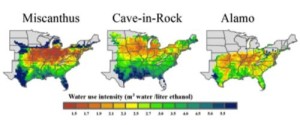
Credit: Atul Jain
A new research of the University of Illinois at Urbana-Champaign, has identified the most suitable regions in the United States where bioenergy crops would grow best, while minimizing effects on water use and quality.
The research was based on the use of detailed models to examine impacts on water quantity and quality, that would occur if existing vegetation was replaced by various bioenergy crops .The study found out that by using a combination of crop growth, hydrological, carbon and nitrogen cycle models, the estimated land suitable for bioenergy grasses -particularly miscanthus, is limited, despite its relatively high biomass productivity and low water consumption per unit of ethanol.
The research has revealed that compared to corn -which is the dominant crop used in biofuel production – bioenergy grasses cause less nitrogen loss due to leakage and irrigation and that their deep root system allows them to draw water and nutrients from deeper soil levels and to be more resilient in poor growing seasons.
“Growing bioenergy grasses, in general can mitigate nitrogen leaching across the United States. However, the greatest reduction in nitrogen leaching occurs when bioenergy crops displace other cropland or grassland, because energy crops consume more water and less nitrogen fertilizer than the crops and grasses that they replace, resulting in less water runoff and nitrogen loss.”


